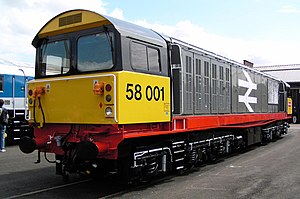British Rail Class 58

58001 at Doncaster Works
|
|||||||||||||||||||||||||||||||||||||||
|
|||||||||||||||||||||||||||||||||||||||
|
|||||||||||||||||||||||||||||||||||||||
|
|||||||||||||||||||||||||||||||||||||||
|
|||||||||||||||||||||||||||||||||||||||
| Type and origin | |
|---|---|
| Power type | Diesel-electric |
| Builder | BREL, Doncaster Works |
| Build date | 1983-1987 |
| Total produced | 50 |
| Specifications | |
|---|---|
| Configuration: |
|
| • Whyte | Co-Co |
| • UIC | Co'Co' |
| Gauge | 1,435 mm (4 ft 8 1⁄2 in) standard gauge |
| Wheel diameter | 1,120 mm (44.09 in) |
| Minimum curve | 4 chains (264.00 ft; 80.47 m) |
| Wheelbase |
bogie: 4.18 m (13 ft 9 in) bogie centres: 14.85 m (48 ft 9 in) |
| Length | 19.13 m (62 ft 9 in) |
| Width | 2.72 m (8 ft 11 in) |
| Height | 3.91 m (12 ft 10 in) |
| Loco weight | 130 tonnes (127.9 long tons; 143.3 short tons) |
| Fuel capacity | 4,480 litres (990 imp gal; 1,180 US gal) |
| Prime mover | Ruston Paxman 12RK3ACT |
| Alternator | Brush BA1101B |
| Traction motors | Brush TM73-62 |
| Cylinder size | 254 mm × 305 mm (10.0 in × 12.0 in), bore x stroke |
| MU working | ◆ Red Diamond |
| Train brakes | Air |
| Performance figures | |
|---|---|
| Maximum speed | 80 mph (129 km/h) |
| Power output |
Engine: 3,300 hp (2,460 kW) At Rail: 2,387 hp (1,780 kW) |
| Tractive effort | Maximum: 60,000 lbf (267 kN) |
| Brakeforce | 60 tonnes (59.1 long tons; 66.1 short tons) |
| Career | |
|---|---|
| Operators |
British Rail EWS / DB Cargo UK |
| Numbers | 58001-58050 |
| Nicknames | Bone |
| Axle load class | Route availability 7 |
The British Rail Class 58 is a class of Co-Co diesel locomotive designed for heavy freight. Introduced in 1983, they followed American practice of modularisation. EWS withdrew them in 2002 after 20 years in service, and 32 were hired abroad – four to the Netherlands, eight to Spain and twenty to France.
In the late 1970s, British Rail wanted to develop a new, low-cost, easily maintainable freight locomotive that would handle the predicted rail freight growth during the 1980s. The Class 56 had a troublesome entry into service, and BR was also keen to enter the export market. Pre-production drawings of the Class 58s referred to them as "Standard Export Locomotives".
Once a design for the new Class 58 had been approved by the British Railways Board, the contract to build the locomotives was awarded to British Rail Engineering Limited (BREL) in Doncaster where work started on a major multi-million pound upgrade of ‘E2’ shop where the locomotives would be manufactured. BREL dropped traditional locomotive construction methods in favour of an entirely new approach – an innovative modular design. This offered savings on construction and maintenance compared to previous locomotive builds. The load-bearing underframe was fitted with exchangeable modules - number 1 cab, radiator, power unit, turbocharger, electrical equipment and number 2 cab. If required, each module could be easily removed from the underframe and replaced.
The narrow body with cabs at either end led to them being given the nickname "Bone" by rail enthusiasts, but the design also made an American-style single cab version possible.
The first locomotive, 58001, was handed over to British Rail at Doncaster Works on 9 December 1982 and delivery of the remainder of the locomotives continued until early 1987 with the final delivery of 58050. This loco was temporarily fitted with a Sepex wheelslip control system, but upon completion experimental testing the equipment was removed before the locomotive entered traffic. SEPEX was central to the design of the Class 60. No export orders were received and so the jigs at Doncaster were dismantled and 58050 became not only the last Class 58 to be built, but the last diesel locomotive to be built at ‘The Plant’.
...
Wikipedia
